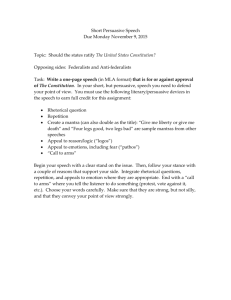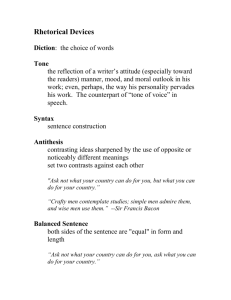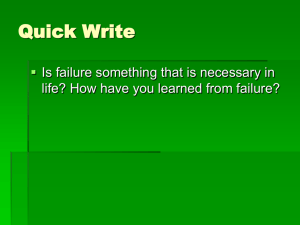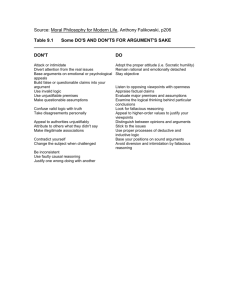Congratulations! You have now been working in your
advertisement
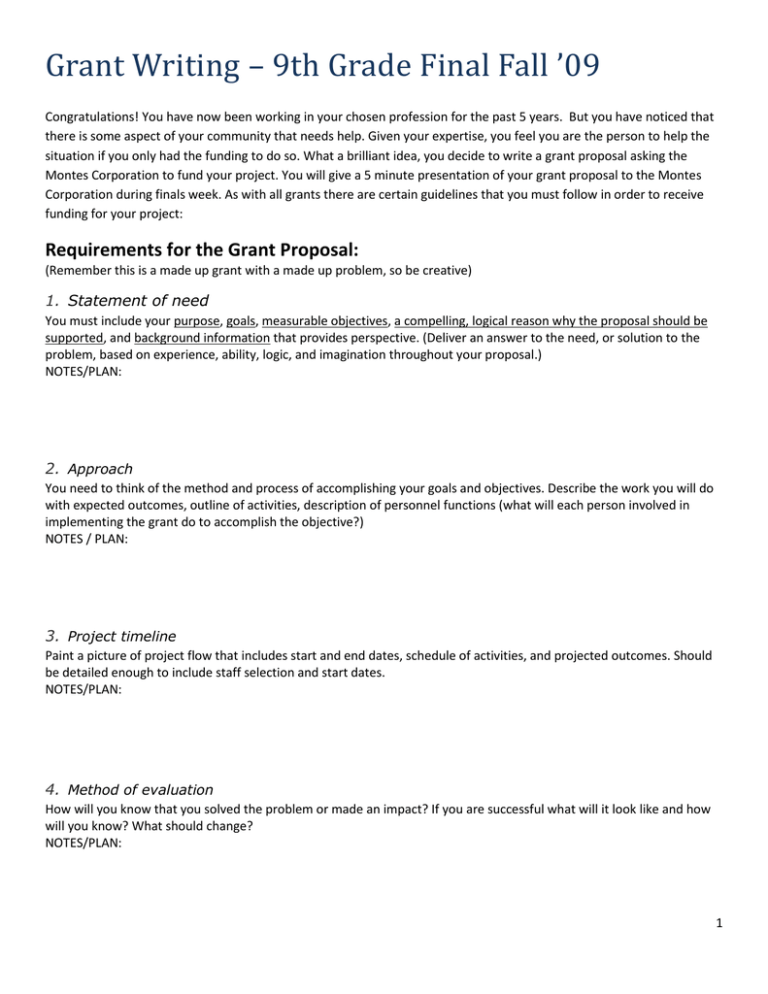
Grant Writing – 9th Grade Final Fall ’09 Congratulations! You have now been working in your chosen profession for the past 5 years. But you have noticed that there is some aspect of your community that needs help. Given your expertise, you feel you are the person to help the situation if you only had the funding to do so. What a brilliant idea, you decide to write a grant proposal asking the Montes Corporation to fund your project. You will give a 5 minute presentation of your grant proposal to the Montes Corporation during finals week. As with all grants there are certain guidelines that you must follow in order to receive funding for your project: Requirements for the Grant Proposal: (Remember this is a made up grant with a made up problem, so be creative) 1. Statement of need You must include your purpose, goals, measurable objectives, a compelling, logical reason why the proposal should be supported, and background information that provides perspective. (Deliver an answer to the need, or solution to the problem, based on experience, ability, logic, and imagination throughout your proposal.) NOTES/PLAN: 2. Approach You need to think of the method and process of accomplishing your goals and objectives. Describe the work you will do with expected outcomes, outline of activities, description of personnel functions (what will each person involved in implementing the grant do to accomplish the objective?) NOTES / PLAN: 3. Project timeline Paint a picture of project flow that includes start and end dates, schedule of activities, and projected outcomes. Should be detailed enough to include staff selection and start dates. NOTES/PLAN: 4. Method of evaluation How will you know that you solved the problem or made an impact? If you are successful what will it look like and how will you know? What should change? NOTES/PLAN: 1 Guidelines for the Grant Writing Process to help you complete the assignment: 1. State your organization's needs and objectives clearly and concisely. Write well. Do not waste words. Use active rather than passive verbs. Use proper grammar and correct spelling. Be clear, factual, supportable, and professional. A well-written proposal is a key factor in the The Montes Corp.’s decision-making process. 2. Be clear about why you are seeking a grant, what you plan to do with the money, and why you are the right person to fix the problem. Prepare an interesting, persuasive and unique proposal. 3. You will be orally presenting this proposal to us. What visual aids, persuasive methods, and / or delivery format works best to help you receive your grant? Website resources: (use your internet powers to find further sources) http://www.npguides.org/index.html http://www.cpb.org/grants/grantwriting.html Be sure to use the following as a checklist (aka CA Standards) to prepare your presentation: _______1.3 Choose logical patterns of organization (e.g., chronological, topical, cause and effect) to inform and to persuade, by soliciting agreement or action, or to unite audiences behind a common belief or cause. _______1.4 Choose appropriate techniques for developing the introduction and conclusion (e.g., by using literary quotations, anecdotes, references to authoritative sources). _______1.5 Recognize and use elements of classical speech forms (e.g., introduction, first and second transitions, body, conclusion) in formulating rational arguments and applying the art of persuasion. _______1.6 Present and advance a clear thesis statement and choose appropriate types of proof (e.g., statistics, testimony, specific instances) that meet standard tests for evidence, including credibility, validity, and relevance. _______1.7 Use props, visual aids, graphs, and electronic media to enhance the appeal and accuracy of presentations. _______1.8 Produce concise notes for extemporaneous delivery. 1.9 Analyze the occasion and the interests of the audience and choose effective verbal and nonverbal techniques (e.g., voice, gestures, eye contact) for presentations. We will also learn these standards to prepare for the final: Speaking Strategies Analysis and Evaluation of Oral and Media Communications 1.10 Analyze historically significant speeches (President Bill Clinton, Sojourner Truth, President Barack Obama) to find the rhetorical devices and features that make them memorable. 1.11 Assess how language and delivery affect the mood and tone of the oral communication and make an impact on the audience. 1.12 Evaluate the clarity, quality, effectiveness, and general coherence of a speaker’s important points, arguments, evidence, organization of ideas, delivery, diction, and syntax. 1.13 Analyze the types of arguments used by the speaker, including argument by causation, analogy, authority, emotion, and logic (ethos, logos, pathos). Speaking Applications 2.5 Deliver persuasive arguments (including evaluation and analysis of problems and solutions and causes and effects): a. Structure ideas and arguments in a coherent, logical fashion. b. Use rhetorical devices to support assertions (e.g., by appeal to logic through reasoning; by appeal to emotion or ethical belief; by use of personal anecdote, case study, or analogy). c. Clarify and defend positions with precise and relevant evidence, including facts, expert 2 opinions, quotations, expressions of commonly accepted beliefs, and logical reasoning. d. Anticipate and address the listener’s concerns and counterarguments. THESE ARE THE 9/10TH GRADE CA LANGUAGE ART STANDARDS THAT WE LEARNED THIS SEMESTER. IF WE BOTH DID OUR JOBS, YOU SHOULD BE ABLE TO USE THESE NEWLY ACQUIRED SKILLS TO COMPLETE YOUR FINAL: Writing Strategies Organization and Focus 1.1 Establish a controlling impression or coherent thesis that conveys a clear and distinctive perspective on the subject and maintain a consistent tone and focus throughout the piece of writing. 1.2 Use precise language, action verbs, sensory details, appropriate modifiers, and the active rather than the passive voice. Research and Technology 1.3 Use clear research questions and suitable research methods (e.g., library, electronic media, personal interview) to elicit and present evidence from primary and secondary sources. 1.4 Develop the main ideas within the body of the composition through supporting evidence (e.g., scenarios, commonly held beliefs, hypotheses, definitions). 1.5 Synthesize information from multiple sources and identify complexities and discrepancies in the information and the different perspectives found in each medium 1.6 Integrate quotations and citations into a written text while maintaining the flow of ideas. 1.7 Use appropriate conventions for documentation in the text, notes, and bibliographies by adhering MLA style Evaluation and Revision 1.9 Revise writing to improve the logic and coherence of the organization and controlling perspective, the precision of word choice, and the tone by taking into consideration the audience, purpose, and formality of the context. Writing Application 2.3 Write expository compositions, including analytical essays and research reports: a. Marshal evidence in support of a thesis and related claims, including information on all relevant perspectives. b. Convey information and ideas from primary and secondary sources accurately and coherently. c. Make distinctions between the relative value and significance of specific data, facts, and ideas. d. Include visual aids by employing appropriate technology to organize and record information on charts, maps, and graphs. e. Anticipate and address readers’ potential misunderstandings, biases, and expectations. f. Use technical terms and notations accurately. 2.4 Write persuasive compositions: a. Structure ideas and arguments in a sustained and logical fashion. b. Use specific rhetorical devices to support assertions (e.g., appeal to logic through reasoning; appeal to emotion or ethical belief; relate a personal anecdote, case study, or analogy) c. Clarify and defend positions with precise and relevant evidence, including facts, expert opinions, quotations, and expressions of commonly accepted beliefs and logical reasoning. d. Address readers’ concerns, counterclaims, biases, and expectations. Reading Comprehension Comprehension and Analysis 2.3 Generate relevant questions about readings on issues that can be researched. 2.4 Synthesize the content from several sources or works by a single author dealing with a single issue; paraphrase the ideas and connect them to other sources and related topics to demonstrate comprehension. 2.5 Extend ideas presented in primary or secondary sources through original analysis, evaluation, and elaboration. Expository Critique 2.8 Evaluate the credibility of an author’s argument or defense of a claim by critiquing the relationship between generalizations and evidence, the comprehensiveness of evidence, and the way in which the author’s intent affects the structure and tone of the text (e.g., in professional journals, editorials, political speeches, primary source material). Pre-Write Reflection: If you had a million dollars, what would you do? 3 PLAN YOUR GRANT PROPOSAL: Choose your topic: Choose your partners: Name______________________________________ Responsibility______________________________ Name______________________________________ Responsibility______________________________ Name______________________________________ Responsibility______________________________ 1. What will you include in your statement of need: 2. What will be your approach to solving the problem: 3. Project Timeline: 4. How will you know if you fixed the problem? (Method of evaluation): 4
